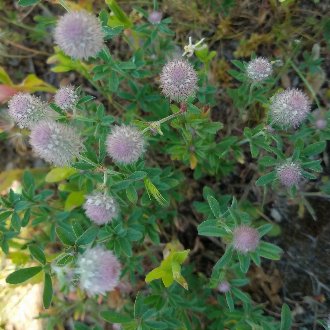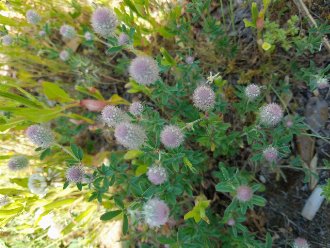Rabbitfoot Clover (Trifolium arvense L.)
↑Summary
An annual clover introduced in North America and invasive in much of the east, favoring dry, nutrient-poor, sandy, disturbed sites.
↑Range - Expand
| Legend | Color |
| Introduced | |
| Introduced or Not Present |
This tentative map is based on our own research. It may have limited data on Canada and/or Mexico, and there is some subjectivity in our assignment of plants as introduced vs. expanded. Read more in this blog post.
Although this plant occurs somewhere in each of these regions, it may only occur in a small part of some or all of them.
↑Description & Identification
Although numerous other plants have similar foliage, when in bloom, this species is visually-distinctive due to its unique fuzzy pinkish gray flowerheads.
↑Habitat
Found primarily in sunny, sandy, disturbed areas in nutrient-poor soils. Occasionally found in a few natural habitats, including upland sand prairies in the west of its range, and coastal sand dunes in the east, but mostly limited to anthropogenic habitats, including roadsides, railroads, sandy fields, and other waste ground. It can survive in mowed lawns and frequently occurs in lawns where the soil is dry, sandy, and/or nutrient poor.
This plant grows best in a full sun exposure where there is little shade and competition from other vegetation, but it can survive on sites where it is shaded on the side, so long as it gets sufficient direct sunlight and has little competition from ground-level vegetation. Prefers dry-mesic sites and requires good drainage. Growth and persistence is best on sandy soil, but it can tolerate some amount of rocky material, as well as loam and clay, in the soil, so long as the soil is nutrient-poor enough to inhibit the growth of other plants. Tolerates a wide range of soil pH, and tolerates sites with extremes of temperature variation.
Within its range it prefers dry-mesic sites, but it requires a humid climate with ample rainfall and is absent from most arid to semiarid regions. In the humid regions where it grows, it relies on disturbance to remove ground-level vegetation to create space for it to thrive.
↑Life Cycle
This species is a summer annual.
Seed typically germinates between June and September, later than many annuals. This timing, after the emergence of most vegetation, typically requires some degree of disturbance in the humid climates where this species occurs.
Plants mature quickly and blooming begins mid-summer and continues for 2-3 months. Plants are self-fertile if not cross-pollinated.
Seed matures gradually and is mostly distributed by wind. The seed is covered in a hard coat of varying thickness; following a period of dormancy, some seed may germinate in the subsequent spring, but much of the seed remains dormant for longer, forming a persistent seed bank.
↑Faunal Associations
This species is slightly better than some invasive plants at supporting insects. The flowers attract a variety of bees, and to a lesser degree, small butterflies and skippers. The larvae of the introduced moth Coleophora deauratella feed on the developing seeds of this and other clovers (Trifolium sp.) but may prefer red clover (Trifolium pratense). The larvae of the native Gray hairstreak (Strymon melinus) butterfly eat the flowers, fruiting bodies, and foliage of this species along with other legumes (Fabaceae) and mallows (Malvaceae.)
In general, clovers (Trifolium sp.), including introduced species, are eaten by a wide variety of insects, including leaf beetles, leaf-miner flies, and various bugs, including aphids. Various birds consume the seeds. However we could not find much material on which of these eat this species specifically.
↑Control
This plant is difficult to control because of its small size, fast maturity, high seed production, wind-dispersed seeds, and large seed production.
Often the best way to reduce or eliminate this plant and/or prevent its establishment is by changing the disturbance regime on a site, refraining from the sort of disturbance that favors this plant, and thus allowing it to get out-competed by other vegetation. Mowing in late winter to early spring, followed by refraining from mowing during the growing season, typically favors other vegetation as this species germinates too late and competes poorly against ground-level vegetation.
In small infestations, this plant can be pulled by hand.
In gardens and landscaping, mulch can be effective for control, as it not only covers the seed and reduces germination, but it provides nutrients and holds moisture, creating moister, nutrient-rich conditions that favors other plants.
Mowing is ineffective at controlling it, as it grows low enough to survive mowing, and it benefits from the removal of competing vegetation.
Herbicide is also ineffective and even counterproductive at controlling this plant. It often occurs in areas, such as roadsides, where herbicide is frequently applied. It is somewhat resistant to glyphosate, but more susceptible to dicamba and sulfonylurea. However, because it has low leaf surface area, matures quickly, and responds favorably to vegetation-removing disturbance, herbicide is often more likely to harm competing vegetation and favor this plant. Herbicide use, particularly in early summer, can allow it to establish after the other vegetation is killed. Pre-emergent herbicides are ineffective for controlling it because of its late germination timing, hard seed coat, and long dormancy period leading to a gradual, staggered germination period.
When this species occurs as a weed in agricultural fields, reducing the amount of phosphorus used in fertilizer can reduce its prevalence, as its growth is often phosphorus-limited. Tillage is ineffective for control as this species tends to benefit from tilling.
↑Uses
This species has been intentionally planted as a cover crop, and used as forage for sheep and goats. It is valued for its ability to thrive in sandy, low-nutrient soils, and for adding nitrogen to the soil.
However, it is invasive in much of the US and it is best to avoid planting it. It also can be harmful to horses and some other livestock if consumed, due to causing abdominal obstructions.
The flowerheads are sometimes used in flower arrangements, although we do not recommend this as such use can spread this species to new areas, especially when flower arrangements are transported over long distances.
↑Links & External Resources
• Trifolium arvense (Rabbit-Foot Clover) | Illinois Wildflowers (About This Site)
• Trifolium arvense (rabbitfoot clover) | USDA PLANTS Database (About This Site)
• Trifolium arvense | Go Botany (About This Site)
• Rabbitfoot Clover | iNaturalist (About This Site)
• Trifolium arvense | Biota of North America Project (BONAP) (About This Site)
• Trifolium arvense | NatureServe Explorer (About This Site)
• Trifolium arvense | Missouri Plants (About This Site)
• Rabbitfoot Clover | Maryland Biodiversity Project (About This Site)
• Trifolium arvense (Rabbit-foot Clover) | Minnesota Wildflowers (About This Site)
• Trifolium arvense L. (Rabbit-foot Clover) | Digital Atlas of the Virginia Flora (About This Site)




